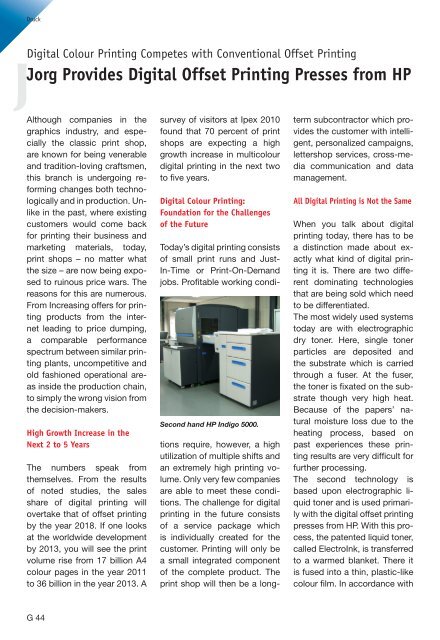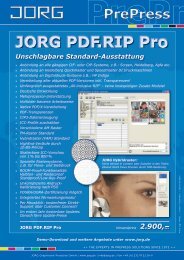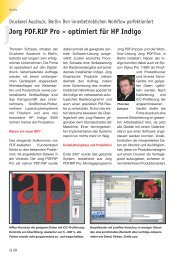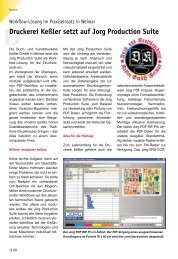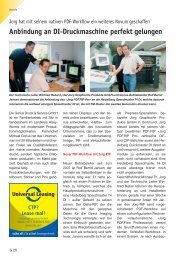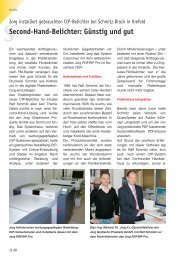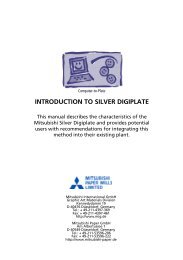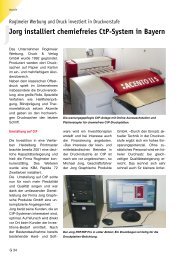Jorg Provides Digital Offset Printing Presses from HP
Jorg Provides Digital Offset Printing Presses from HP
Jorg Provides Digital Offset Printing Presses from HP
Create successful ePaper yourself
Turn your PDF publications into a flip-book with our unique Google optimized e-Paper software.
Druck<br />
J<strong>Digital</strong> Colour <strong>Printing</strong> Competes with Conventional <strong>Offset</strong> <strong>Printing</strong><br />
<strong>Jorg</strong> <strong>Provides</strong> <strong>Digital</strong> <strong>Offset</strong> <strong>Printing</strong> <strong>Presses</strong> <strong>from</strong> <strong>HP</strong><br />
Although companies in the<br />
graphics industry, and especially<br />
the classic print shop,<br />
are known for being venerable<br />
and tradition-loving craftsmen,<br />
this branch is undergoing reforming<br />
changes both technologically<br />
and in production. Unlike<br />
in the past, where existing<br />
customers would come back<br />
for printing their business and<br />
marketing materials, today,<br />
print shops – no matter what<br />
the size – are now being exposed<br />
to ruinous price wars. The<br />
reasons for this are numerous.<br />
From Increasing offers for printing<br />
products <strong>from</strong> the internet<br />
leading to price dumping,<br />
a comparable performance<br />
spectrum between similar printing<br />
plants, uncompetitive and<br />
old fashioned operational areas<br />
inside the production chain,<br />
to simply the wrong vision <strong>from</strong><br />
the decision-makers.<br />
High Growth Increase in the<br />
Next 2 to 5 Years<br />
The numbers speak <strong>from</strong><br />
themselves. From the results<br />
of noted studies, the sales<br />
share of digital printing will<br />
overtake that of offset printing<br />
by the year 2018. If one looks<br />
at the worldwide development<br />
by 2013, you will see the print<br />
volume rise <strong>from</strong> 17 billion A4<br />
colour pages in the year 2011<br />
to 36 billion in the year 2013. A<br />
G 44<br />
survey of visitors at Ipex 2010<br />
found that 70 percent of print<br />
shops are expecting a high<br />
growth increase in multicolour<br />
digital printing in the next two<br />
to fi ve years.<br />
<strong>Digital</strong> Colour <strong>Printing</strong>:<br />
Foundation for the Challenges<br />
of the Future<br />
Today’s digital printing consists<br />
of small print runs and Just-<br />
In-Time or Print-On-Demand<br />
jobs. Profi table working condi-<br />
Second hand <strong>HP</strong> Indigo 5000.<br />
tions require, however, a high<br />
utilization of multiple shifts and<br />
an extremely high printing volume.<br />
Only very few companies<br />
are able to meet these conditions.<br />
The challenge for digital<br />
printing in the future consists<br />
of a service package which<br />
is individually created for the<br />
customer. <strong>Printing</strong> will only be<br />
a small integrated component<br />
of the complete product. The<br />
print shop will then be a long-<br />
term subcontractor which provides<br />
the customer with intelligent,<br />
personalized campaigns,<br />
lettershop services, cross-media<br />
communication and data<br />
management.<br />
All <strong>Digital</strong> <strong>Printing</strong> is Not the Same<br />
When you talk about digital<br />
printing today, there has to be<br />
a distinction made about exactly<br />
what kind of digital printing<br />
it is. There are two different<br />
dominating technologies<br />
that are being sold which need<br />
to be differentiated.<br />
The most widely used systems<br />
today are with electrographic<br />
dry toner. Here, single toner<br />
particles are deposited and<br />
the substrate which is carried<br />
through a fuser. At the fuser,<br />
the toner is fi xated on the substrate<br />
though very high heat.<br />
Because of the papers’ natural<br />
moisture loss due to the<br />
heating process, based on<br />
past experiences these printing<br />
results are very diffi cult for<br />
further processing.<br />
The second technology is<br />
based upon electrographic liquid<br />
toner and is used primarily<br />
with the digital offset printing<br />
presses <strong>from</strong> <strong>HP</strong>. With this process,<br />
the patented liquid toner,<br />
called ElectroInk, is transferred<br />
to a warmed blanket. There it<br />
is fused into a thin, plastic-like<br />
colour fi lm. In accordance with
the thermo-offset principle, the<br />
heated toner is adhered onto a<br />
cooler substrate after contact<br />
and is immediately hardened.<br />
As soon as the substrate leaves<br />
the press it is dry and can<br />
immediately be processed<br />
further.<br />
<strong>Digital</strong> <strong>Printing</strong> <strong>Presses</strong><br />
Supplement Conventional<br />
<strong>Offset</strong> <strong>Printing</strong><br />
Already today you will fi nd<br />
countless <strong>HP</strong> Indigo digital<br />
printing presses in print shops<br />
that supplement the existing<br />
presses. The advantages of this<br />
digital printing process are very<br />
clear. In contrast to conventional<br />
offset printing, there are no<br />
prepress processes like fi lm or<br />
plate making with chemical or<br />
other waste disposal and there<br />
is no make-ready, registration<br />
or ink adjustments on the<br />
printing press. <strong>HP</strong> Indigo offset<br />
printing presses work completely<br />
digital <strong>from</strong> the page design<br />
to print. Every impression<br />
can be individual and variable<br />
<strong>from</strong> one print to the next. The<br />
printing process is, therefore,<br />
equated to as »digital offset<br />
printing.«<br />
<strong>Jorg</strong> Has Recognized This<br />
Changing Trend<br />
JORG Graphische Produkte<br />
GmbH, known as the Germany-wide<br />
leading supplier for<br />
second-hand CtP systems and<br />
highly productive workfl ow<br />
solutions, has recognized this<br />
changing technological trend<br />
and, since 2010, has used their<br />
existing Know-How to concentrate<br />
on the distribution of used<br />
and well-maintained <strong>HP</strong> Indigo<br />
printing presses. Because of<br />
the considerably lower investment<br />
costs in comparison to a<br />
new press, even small and medium-sized<br />
print shops are able<br />
to meet this rapidly advancing<br />
structural change.<br />
No Follow-Up Costs through<br />
Maintenance and Click-Price<br />
Contracts<br />
The acquisition of a used <strong>HP</strong><br />
Indigo digital printing press<br />
<strong>from</strong> the systems supplier <strong>Jorg</strong><br />
takes place without an expensive<br />
and binding maintenance<br />
contract. That means the high<br />
monthly click and maintenance<br />
Druck<br />
Customers can buy original consumablies<br />
»On Demand« <strong>from</strong> <strong>Jorg</strong><br />
<strong>HP</strong> stock<br />
costs that would come <strong>from</strong> the<br />
supplier are dropped. Original<br />
<strong>HP</strong> Indigo consumables can<br />
be bought <strong>from</strong> <strong>Jorg</strong> through<br />
the »Buy Supplies on Demand«<br />
model. The customer only buys<br />
what is really needed and consumed.<br />
<strong>Jorg</strong> Graphische Produkte GmbH<br />
Tel. 02 31 / 7 92 22 40<br />
G 45


